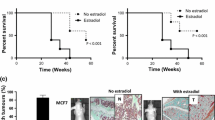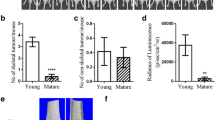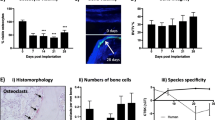Abstract
Breast cancer (BC) is the leading cancer in women worldwide. Metastasis occurs in stage IV BC with bone and lung being common metastatic sites. Here we evaluate the effects of the aromatase inhibitor letrozole on BC micro-metastatic tumor growth in bone and lung metastasis in intact and ovariectomized (OVX) mice with murine estrogen receptor negative (ER−) BC cells inoculated in tibia. Forty-eight BALB/c mice were randomly assigned to one of four groups: OVX, OVX + Letrozole, Intact, and Intact + Letrozole, and injected with 4T1 cells intra-tibially. Letrozole was subcutaneously injected daily for 23 days at a dose of 1.75 µg/g body weight. Tumor progression was monitored by bioluminescence imaging (BLI). Following necropsy, inoculated tibiae were scanned via µCT and bone response to tumor was scored from 0 (no ectopic mineralization/osteolysis) to 5 (extensive ectopic mineralization/osteolysis). OVX mice had higher tibial pathology scores indicative of more extensive bone destruction than intact mice, irrespective of letrozole treatment. Letrozole decreased serum estradiol levels and reduced lung surface tumor numbers in intact animals. Furthermore, mice receiving letrozole had significantly fewer tumor colonies and fewer proliferative cells in the lung than OVX and intact controls based on H&E and Ki-67 staining, respectively. In conclusion, BC-inoculated OVX animals had higher tibia pathology scores than BC-inoculated intact animals and letrozole reduced BC metastases to lungs. These findings suggest that, by lowering systemic estrogen level and/or by interacting with the host organ, the aromatase inhibitor letrozole has the potential to reduce ER− BC metastasis to lung.






Similar content being viewed by others
Abbreviations
- BC:
-
Breast cancer
- BLI:
-
Bioluminescence imaging
- E2:
-
Estradiol
- ER:
-
Estrogen receptor
- ER+:
-
Estrogen receptor positive
- ER−:
-
Estrogen receptor negative
- H&E:
-
Hematoxylin & eosin
- HI-FBS:
-
Heat inactivated-fetal bovine serum
- IMEM:
-
Iscove’s modified essential medium
- µCT:
-
Micro computed tomography
- MCF-7:
-
Michigan cancer foundation-7
- OVX:
-
Ovariectomized
- PBS:
-
Phosphate buffered saline
References
Mitropoulou TN, Tzanakakis GN, Kletsas D, Kalofonos HP, Karamanos NK (2003) Letrozole as a potent inhibitor of cell proliferation and expression of metalloproteinases (MMP-2 and MMP-9) by human epithelial breast cancer cells. Int J Cancer 104(2):155–160
Kim EJ, Shin M, Park H, Hong JE, Shin HK, Kim J et al (2009) Oral administration of 3,3′-diindolylmethane inhibits lung metastasis of 4T1 murine mammary carcinoma cells in BALB/c mice. J Nutr 139(12):2373–2379
Lee YT (1983) Breast carcinoma: pattern of metastasis at autopsy. J Surg Oncol 23(3):175–180
Guise T (2013) Breast cancer bone metastases: it’s all about the neighborhood. Cell 154(5):957–959
Martin M, Bell R, Bourgeois H, Brufsky A, Diel I, Eniu A et al (2012) Bone-related complications and quality of life in advanced breast cancer: results from a randomized phase III trial of denosumab versus zoledronic acid. Clin Cancer Res 18(17):4841–4849
Santen RJ, Yue W, Heitjan DF (2013) Occult breast tumor reservoir: biological properties and clinical significance. Horm Cancer 4(4):195–207
Chen YC, Prabhu KS, Das A, Mastro AM (2013) Dietary selenium supplementation modifies breast tumor growth and metastasis. Int J Cancer 133(9):2054–2064
Tester AM, Ruangpanit N, Anderson RL, Thompson EW (2000) MMP-9 secretion and MMP-2 activation distinguish invasive and metastatic sublines of a mouse mammary carcinoma system showing epithelial-mesenchymal transition traits. Clin Exp Metastasis 18(7):553–560
Braun S, Vogl FD, Naume B, Janni W, Osborne MP, Coombes RC et al (2005) A pooled analysis of bone marrow micrometastasis in breast cancer. N Engl J Med 353(8):793–802
Fidler IJ, Kim S, Langley RR (2007) The role of the organ microenvironment in the biology and therapy of cancer metastasis. J Cell Biochem 101(4):927–936
Nassa G, Tarallo R, Guzzi PH, Ferraro L, Cirillo F, Ravo M et al (2011) Comparative analysis of nuclear estrogen receptor alpha and beta interactomes in breast cancer cells. Mol BioSyst 7(3):667–676
Luthra R, Kirma N, Jones J, Tekmal RR (2003) Use of letrozole as a chemopreventive agent in aromatase overexpressing transgenic mice. J Steroid Biochem Mol Biol 86(3–5):461–467
Macedo LF, Sabnis G, Brodie A (2009) Aromatase inhibitors and breast cancer. Ann N Y Acad Sci 1155:162–173
Campos SM (2004) Aromatase inhibitors for breast cancer in postmenopausal women. Oncologist 9(2):126–136
Herold CI, Blackwell KL (2008) The impact of adjuvant endocrine therapy on reducing the risk of distant metastases in hormone-responsive breast cancer. Breast 17(Suppl 1):S15–S24
Puglisi F, Minisini AM (2010) Adjuvant endocrine therapy in postmenopausal breast cancer patients: does hormone receptor status influence decision-making? Crit Rev Oncol Hematol 77(2):87–99
Del Mastro L, Clavarezza M, Venturini M (2007) Reducing the risk of distant metastases in breast cancer patients: role of aromatase inhibitors. Cancer Treat Rev 33(8):681–687
Ingle JN (2013) Postmenopausal women with hormone receptor-positive breast cancer: balancing benefit and toxicity from aromatase inhibitors. Breast 22(Supplement 2):S180–S183
Mincey BA, Duh MS, Thomas SK, Moyneur E, Marynchencko M, Boyce SP et al (2006) Risk of cancer treatment—associated bone loss and fractures among women with breast cancer receiving aromatase inhibitors. Clin Breast Cancer 7(2):127–132
Bauer KR, Brown M, Cress RD, Parise CA, Caggiano V (2007) Descriptive analysis of estrogen receptor (ER)-negative, progesterone receptor (PR)-negative, and HER2-negative invasive breast cancer, the so-called triple-negative phenotype. Cancer 109(9):1721–1728
Gupta PB, Kuperwasser C (2006) Contributions of estrogen to ER-negative breast tumor growth. J Steroid Biochem Mol Biol 102(1–5):71–78
Gupta PB, Proia D, Cingoz O, Weremowicz J, Naber SP, Weinberg RA et al (2007) Systemic stromal effects of estrogen promote the growth of estrogen receptor-negative cancers. Cancer Res 67(5):2062–2071
Yang X, Belosay A, Du M, Fan TM, Turner RT, Iwaniec UT et al (2013) Estradiol increases ER-negative breast cancer metastasis in an experimental model. Clin Exp Metastasis 30(6):711–721
You S, Zuo L, Li W (2010) Optimizing the time of Doxil injection to increase the drug retention in transplanted murine mammary tumors. Int J Nanomed 7(5):221–229
Dabydeen SA, Kang K, Diaz-Cruz ES, Alamri A, Axelrod ML, Bouker KB et al (2015) Comparison of tamoxifen and letrozole response in mammary preneoplasia of ER and aromatase overexpressing mice defines an immune-associated gene signature linked to tamoxifen resistance. Carcinogenesis 36(1):122–132
Martin LA, Pancholi S, Farmer I, Guest S, Ribas R, Weigel MT et al (2012) Effectiveness and molecular interactions of the clinically active mTORC1 inhibitor everolimus in combination with tamoxifen or letrozole in vitro and in vivo. Breast Cancer Res 14(5):R132
Fowler AM, Chan SR, Sharp TL, Fettig NM, Zhou D, Dence CS et al (2012) Small-animal PET of steroid hormone receptors predicts tumor response to endocrine therapy using a preclinical model of breast cancer. J Nucl Med 53(7):1119–1126
Brodie A, Sabnis G, Macedo L (2007) Xenograft models for aromatase inhibitor studies. J Steroid Biochem Mol Biol 106(1–5):119–124
Macedo LF, Sabnis G, Brodie A (2008) Preclinical modeling of endocrine response and resistance: focus on aromatase inhibitors. Cancer 112(3 Suppl):679–688
Jelovac D, Macedo L, Handratta V, Long BJ, Goloubeva OG, Ingle JN et al (2004) Effects of exemestane and tamoxifen in a postmenopausal breast cancer model. Clin Cancer Res 10(21):7375–7381
Jelovac D, Macedo L, Goloubeva OG, Handratta V, Brodie AM (2005) Additive antitumor effect of aromatase inhibitor letrozole and antiestrogen fulvestrant in a postmenopausal breast cancer model. Cancer Res 65(12):5439–5444
Allred CD, Allred KF, Ju YH, Clausen LM, Doerge DR, Schantz SL et al (2004) Dietary genistein results in larger MNU-induced, estrogen-dependent mammary tumors following ovariectomy of Sprague-Dawley rats. Carcinogenesis 25(2):211–218
Churchwell MI, Camacho L, Vanlandingham MM, Twaddle NC, Sepehr E, Delclos KB et al (2014) Comparison of life-stage-dependent internal dosimetry for bisphenol A, ethinyl estradiol, a reference estrogen, and endogenous estradiol to test an estrogenic mode of action in sprague dawley rats. Toxicol Sci 139(1):4-20
Filardi MJ, Lininger L, McKneally MF (1977) Adaptation of an automatic bacterial colony counter for measuring lung tumor growth in mice. Cancer Res 37(8 Pt 1):2726–2728
Wexler H, Chretien PB, Ketcham AS, Sindelar WF (1975) Induction of pulmonary metastases in both immune and nonimmune mice. Effect of the removal of a transplanted primary tumor. Cancer 36(6):2042–2047
Lucci A, Krishnamurthy S, Singh B, Bedrosian I, Meric-Bernstam F, Reuben J et al (2009) Cyclooxygenase-2 expression in primary breast cancers predicts dissemination of cancer cells to the bone marrow. Breast Cancer Res Treat 117(1):61–68
Fidler IJ (2003) The pathogenesis of cancer metastasis: the ‘seed and soil’ hypothesis revisited. Nat Rev Cancer 3(6):453–458
Kakonen SM, Mundy GR (2003) Mechanisms of osteolytic bone metastases in breast carcinoma. Cancer 97(3 Suppl):834–839
Murphy BO, Joshi S, Kessinger A, Reed E, Sharp JG (2002) A murine model of bone marrow micrometastasis in breast cancer. Clin Exp Metastasis 19(7):561–569
Muraoka RS, Dumont N, Ritter CA, Dugger TC, Brantley DM, Chen J et al (2002) Blockade of TGF-beta inhibits mammary tumor cell viability, migration, and metastases. J Clin Investig 109(12):1551–1559
Wilson C, Holen I, Coleman RE (2012) Seed, soil and secreted hormones: potential interactions of breast cancer cells with their endocrine/paracrine microenvironment and implications for treatment with bisphosphonates. Cancer Treat Rev 38(7):877–889
de Almeida PE, van Rappard JRM, Wu JC (2011) In vivo bioluminescence for tracking cell fate and function. Am J Physiol Heart Circ Physiol 301(3):H663–H671
Sun A, Hou L, Prugpichailers T, Dunkel J, Kalani MA, Chen X et al (2010) Firefly luciferase-based dynamic bioluminescence imaging: a noninvasive technique to assess tumor angiogenesis. Neurosurgery 66(4):751–757 (discussion 757)
Banka CL, Lund CV, Nguyen MTN, Pakchoian AJ, Mueller BM, Eliceiri BP (2006) Estrogen induces lung metastasis through a host compartment-specific response. Cancer Res 66(7):3667–3672
Bonelli MA, Fumarola C, Alfieri RR, La Monica S, Cavazzoni A, Galetti M et al (2010) Synergistic activity of letrozole and sorafenib on breast cancer cells. Breast Cancer Res Treat 124(1):79–88
Neville-Webbe HL, Coleman RE, Holen I (2010) Combined effects of the bisphosphonate, zoledronic acid and the aromatase inhibitor letrozole on breast cancer cells in vitro: evidence of synergistic interaction. Br J Cancer 102(6):1010–1017
Ma G, He J, Yu Y, Xu Y, Yu X, Martinez J et al (2015) Tamoxifen inhibits ER-negative breast cancer cell invasion and metastasis by accelerating Twist1 degradation. Int J Biol Sci 11(5):618–628
Ju YH, Allred KF, Allred CD, Helferich WG (2006) Genistein stimulates growth of human breast cancer cells in a novel, postmenopausal animal model, with low plasma estradiol concentrations. Carcinogenesis 27(6):1292–1299
Ju YH, Doerge DR, Woodling KA, Hartman JA, Kwak J, Helferich WG (2008) Dietary genistein negates the inhibitory effect of letrozole on the growth of aromatase-expressing estrogen-dependent human breast cancer cells (MCF-7Ca) in vivo. Carcinogenesis 29(11):2162–2168
Ju YH, Fultz J, Allred KF, Doerge DR, Helferich WG (2006) Effects of dietary daidzein and its metabolite, equol, at physiological concentrations on the growth of estrogen-dependent human breast cancer (MCF-7) tumors implanted in ovariectomized athymic mice. Carcinogenesis 27(4):856–863
Heshmati HM, Khosla S, Robins SP, O’Fallon WM, Melton LJ, Riggs BL (2002) Role of low levels of endogenous estrogen in regulation of bone resorption in late postmenopausal women. J Bone Miner Res 17(1):172–178
Yang X, Belosay A, Hartman JA, Song H, Zhang Y, Wang W et al (2015) Dietary soy isoflavones increase metastasis to lungs in an experimental model of breast cancer with bone micro-tumors. Clin Exp Metastasis 32(4):323–333
Pulaski BA, Ostrand-Rosenberg S (2001) Mouse 4T1 breast tumor model. Current protocols in immunology. Wiley, New York
Tao K, Fang M, Alroy J, Sahagian GG (2008) Imagable 4T1 model for the study of late stage breast cancer. BMC Cancer 8:228
Xanthopoulos JM, Romano AE, Majumdar SK (2005) Response of mouse breast cancer cells to anastrozole, tamoxifen, and the combination. J Biomed Biotechnol 2005(1):10–19
Michigami T, Hiraga T, Williams PJ, Niewolna M, Nishimura R, Mundy GR et al (2002) The effect of the bisphosphonate ibandronate on breast cancer metastasis to visceral organs. Breast Cancer Res Treat 75(3):249–258
Iyer V, Klebba I, McCready J, Arendt LM, Betancur-Boissel M, Wu MF et al (2012) Estrogen promotes ER-negative tumor growth and angiogenesis through mobilization of bone marrow-derived monocytes. Cancer Res 72(11):2705–2713
Roy S, Chakravarty D, Cortez V, Mukhopadhyay KD, Bandyopadhyay A, Ahn JM et al. (2011) Significance of PELP1 in ER-negative breast cancer metastasis. Mol Cancer Res
Zhang S, Kim K, Jin UH, Pfent C, Cao H, Amendt B et al (2012) Aryl Hydrocarbon receptor agonists induce microRNA-335 expression and inhibit lung metastasis of estrogen receptor negative breast cancer cells. Mol Cancer Ther 11(1):108–118
Hoefnagel L, van de Vijver MJ, van Slooten H, Wesseling P, Wesseling J, Westenend P et al (2010) Receptor conversion in distant breast cancer metastases. Breast Cancer Res 12(5):75
MacRitchie AN, Jun SS, Chen Z, German Z, Yuhanna IS, Sherman TS et al (1997) Estrogen upregulates endothelial nitric oxide synthase gene expression in fetal pulmonary artery endothelium. Circ Res 81(3):355–362
Koehler KF, Helguero LA, Haldosén L, Warner M, Gustafsson J (2005) Reflections on the discovery and significance of estrogen receptor ß. Endocr Rev 26(3):465–478
Acknowledgments
This project was supported by Grant Number W81XWH-09-1-0689; BC085882 (WGH) from DOD Breast Cancer Research Program from U.S. Army Medical Research and Materiel Command and P50AT006268 (WGH) from the National Center for Complementary and Integrative Health (NCCIH), the Office of Dietary Supplements (ODS) and the National Cancer Institute (NCI). Its contents are solely the responsibility of the authors and do not necessarily represent the official views of the NCCIH, ODS, NCI, or the National Institutes of Health.
Author information
Authors and Affiliations
Corresponding author
Electronic supplementary material
Below is the link to the electronic supplementary material.
Rights and permissions
About this article
Cite this article
Wang, W., Belosay, A., Yang, X. et al. Effects of letrozole on breast cancer micro-metastatic tumor growth in bone and lung in mice inoculated with murine 4T1 cells. Clin Exp Metastasis 33, 475–485 (2016). https://doi.org/10.1007/s10585-016-9792-z
Received:
Accepted:
Published:
Issue Date:
DOI: https://doi.org/10.1007/s10585-016-9792-z




